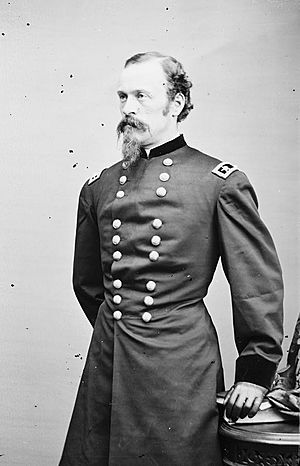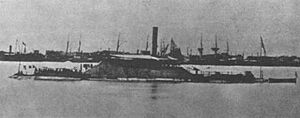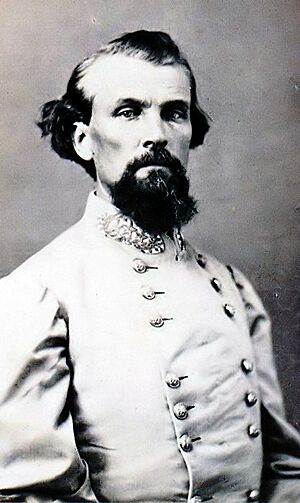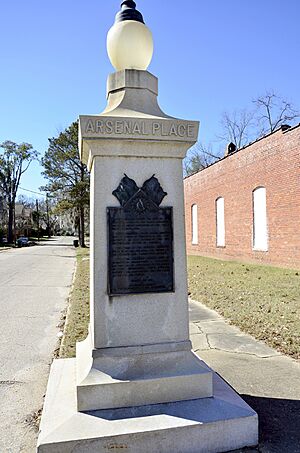Selma, Alabama, in the American Civil War facts for kids
Selma, Alabama was a super important city for the South during the American Civil War. It was a major center for making military supplies. Selma produced huge amounts of weapons, ammunition, and even built warships for the Confederacy. The city had a big complex that included a naval foundry (where metal was melted and shaped), a shipyard, an army arsenal (a place to store and make weapons), and factories for gunpowder. After the Battle of Selma, Union General James H. Wilson's soldiers destroyed many of Selma's factories and much of the city.
Why Selma Was So Important to the Confederacy
Selma was a perfect spot for making war supplies because of its location and train lines. The Confederacy quickly saw its value for producing cartridges (bullets), gunpowder, cannonballs, rifles, cannon, and even special ships called steam rams.
By 1863, Selma was making most of the South's military equipment. About ten thousand people worked there! Selma was one of only two places (the other was Tredegar Iron Works in Richmond) that made the powerful Brooke rifle. This was a special cannon used by the navy and for defending coasts.
The city's shipyard also built the hulls (main bodies) for several Confederate ironclad warships. These included the CSS Huntsville, CSS Phoenix, CSS Tennessee, and CSS Tuscaloosa. The CSS Nashville was also partly equipped in Selma.
Early Attempts to Capture Selma
The North knew how important Selma was to the Confederate war effort as early as 1862. But it was very hard to reach because it was far from the front lines. As Selma became more vital to the South, capturing it became even more necessary for the North.
- In 1863, Union General Benjamin Grierson tried to reach Selma with his cavalry from Memphis, but he was stopped and had to turn back.
- In February 1864, General William Tecumseh Sherman tried to get there. He got as close as Meridian, which was about 107 miles (172 km) from Selma, but then he retreated.
- Later in 1864, General Lovell Rousseau also made a quick move toward Selma. However, his guides led him astray, and he ended up about 90 miles (145 km) east of the city instead.
The Battle of Selma

In early 1865, Union General James H. Wilson led a large cavalry force towards Selma. He sent one group to destroy Confederate property in Tuscaloosa, Alabama. Wilson also captured a Confederate messenger carrying important information from General Nathan Bedford Forrest. This information helped Wilson cut off most of Forrest's backup troops by destroying a bridge. This started a series of fights that continued until Selma fell.
On April 1, 1865, Wilson's lead troops met Forrest's soldiers at Ebenezer Church. Forrest hoped to gather all his men there, but bad weather and earlier fights meant he had less than 2,000 soldiers. Many of these were not experienced fighters but older men and young boys.
The Confederates were outnumbered and outgunned. They fought for over an hour as more Union cavalry and cannons arrived. General Forrest himself was wounded but managed to kill the Union captain who attacked him. Finally, a Union cavalry charge broke through the Confederate lines, forcing Forrest to retreat.
Forrest arrived in Selma early the next morning, covered in blood. He told General Richard Taylor, the local commander, to leave the city. Taylor did, giving Forrest command of Selma's defense.
Selma was protected by three miles of strong defenses that curved around the city. These defenses were anchored by the Alabama River on both sides. They were 8 to 12 feet (2.4 to 3.7 m) high and 15 feet (4.6 m) thick at the bottom. In front of them was a ditch 4 feet (1.2 m) wide and 5 feet (1.5 m) deep. There was also a fence of sharpened posts. At key points, earth forts with cannons were built to cover the areas where an attack would happen.
Forrest had less than 4,000 defenders, and only about half of them were reliable soldiers. The Selma defenses were built for 20,000 men, so Forrest's soldiers had to stand far apart.
Wilson's army arrived at Selma's defenses at 2 p.m. He had about 9,000 troops ready to attack.
Wilson's plan was to send a small group of 300 men after dark to cross a swamp on the Confederate right side. They would enter the defenses and attack from the side. Then, a single cannon shot would signal the main attack by all Union forces.
However, at 5 p.m., General Long's ammunition wagons were attacked by some of Forrest's scattered troops. Long decided to start his attack on Selma's defenses early to stop the enemy behind him.
Long's troops attacked in three lines, on foot, firing their carbines. Confederate soldiers fired back with heavy rifle and cannon fire. The Southern cannons, strangely, only had solid cannonballs, even though a short distance away was a factory making tons of canister shot (a type of ammunition like a giant shotgun blast, very effective against groups of soldiers).
The Union soldiers suffered many injuries, including General Long himself, but they kept attacking. Once they reached the defenses, there was fierce hand-to-hand fighting. Many soldiers were hit with rifle butts. But in less than 30 minutes, Long's men captured the defenses on their side.
Meanwhile, General Upton saw Long's success and ordered his division forward. His men had a similar experience. Soon, Union flags were flying over the defenses all around Selma.
After the outer defenses fell, General Wilson himself led a mounted charge down a road toward the unfinished inner defenses. The retreating Confederate soldiers gathered at these inner defenses and fired heavily at the charging Union column. This stopped the charge, and General Wilson fell to the ground when his horse was wounded. He quickly got back on his horse and ordered his men to attack on foot.
Mixed groups of Confederate troops also held the Selma railroad depot and the nearby railroad tracks. The fighting there was intense. But by 7 p.m., the larger number of Union troops managed to get around the Southern positions, forcing them to leave the depot and the inner defenses.
In the darkness, the Union soldiers captured hundreds of prisoners. But hundreds more, including Generals Forrest, Armstrong, and Roddey, escaped down a road. To the west, many Confederate soldiers fought the Union pursuers all the way to Valley Creek. They escaped in the dark by swimming across the Alabama River.
That night, Union soldiers looted the city. Many businesses and homes were burned. The Union troops spent the next week destroying the arsenal and naval foundry. Then, they left Selma and headed to Montgomery.
|





